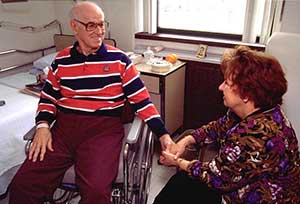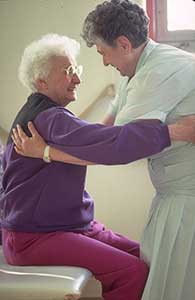
- Chronic pain is defined as pain lasting more than six months. Another name for this type of pain is “persistent” pain. People who suffer with this long-term pain say it impacts not only their physical bodies, but their emotions and energy levels as well. Chronic pain impacts not only the person’s life, but the lives of those around them as well.
- Chronic pain may be difficult to treat. Other people may not realize how much pain the person has. This may leave the person in pain feeling that they are not valued or appreciated.
- Each person will experience chronic pain in their own way. How a person shows he or she is in pain is based on many factors, such as their culture. In some cultures, people may hide their pain while in other cultures it may be more common to see people express their pain by words or actions.
- People with cognitive changes, or memory problems, like dementia or Alzheimer disease, may not be able to say they are in pain, but they may show it in how they act. (see Pain and Dementia module).
- Chronic pain can impact how well the person sleeps. It can result in them feeling very tired even when they do get enough sleep. They may experience depression and may have poor eating habits. In many cases the person with this type of pain ends up spending a lot of time alone. They may not be able to get around as easily and may need help to manage their care.
- Chronic pain is listed as one of the top chronic conditions among those 65 years and older in Canada. Some forms of chronic pain cannot be cured, however there are number of treatments that may help. People with chronic pain are encouraged to try more than one approach to find the combination that works best for them.
 There are a number of conditions that cause pain, including:
There are a number of conditions that cause pain, including:
- Fibromyalgia
- Arthritis-Rheumatoid or Osteoarthritis
- Injury, such as Back Injury
- Spinal Injury/Stenosis
- Headaches
- Cancer
- Loss of a limb, or “Phantom Pain”
- Sciatica
- Shingles
Origins of Pain:
- When pain involves the nerves of the body (also known as neuropathic pain), the pain is often sudden, sharp, severe. People describe this pain as a having a sensation of “burning, numbness or tingling.” This kind of pain can radiate, or feel like it is travelling from the source of the pain to another part of the body, such as from a hip down the side or back of your leg.
- When pain involves an organ in the body (also known as visceral pain), the pain is often described as “deep, achy or cramping.” People say this type of pain is often constant and that it can be difficult to pinpoint where the pain is coming from.
- Pain that involves the tissues of the body, such as skin, muscles, bones and joints is called somatic pain. This kind of pain can be either constant (there all the time), or it can ‘come and go.’ People describe this pain as “gnawing, achy, or dull” and often say that it gets worse when they move or put pressure on the area.
Assessing pain helps the health care provider figure out which type of pain the person is having. A complete assessment will help determine which treatment, or treatments, would be most helpful. A good plan for managing pain helps the person feel more in control, and can help improve communication between the person in pain, their family and health care providers.
Treatments for Pain

There are a number of types of treatment that have been shown to help with pain that do not involve medicines. These include:
1. Physical Therapy-type treatments
- Low-level activities and exercise
- Heat therapy
- Cold therapy
- Hydro therapy, or low impact exercise in water (for example, aquasize)
- Swimming
- TENS, or Transcutaneous electrical nerve stimulation
- Massage therapy
- Acupuncture
2. Alternative treatments
- Music therapy
- Biofeedback/mental imagery
- Meditation
- Support groups
- Pet therapy
- Yoga
3. Lifestyle changes
- No smoking
- Eating a healthy diet - which may include adding vitamin supplements
- Getting enough sleep and rest
4. Special Considerations
- Encourage the person to keep moving as much as possible. Walking aids, like a properly fitting cane, may help the person be more stable and improve their posture. If person cannot move well, certain exercises may need to be modified. Your health care providers can give suggestions to help the person move safely.
- Allow the person with chronic pain to express their thoughts and feelings about their pain and what it means to them. This helps them feel valued.
- Try to make things easier around the home. Could some items to be moved to make things easier to reach? Could someone be hired to help with the yard work?
- Does the home need special equipment to help the person manage better? Would railings or a ramp help around stairs? Are grab bars, a bath seat or raised toilet seat needed? Are there items that put the person at risk of falling, such as scatter rugs or other obstructions?
- Ask your health team if a home assessment can be arranged to spot areas that could be improved.
Medications that are used to help decrease pain are known as analgesics.
 For mild pain, analgesics such as acetaminophen (Tylenol®),
ibuprofen (Advil® or Motrin®), acetylsalicylic acid (ASA or Aspirin®), and diclofenac (Voltaren) can be useful. These medications are also called “NSAID’s” which is short for “non-steroidal inflammatory drugs” Many of these medications are available
without a prescription at a drug-store or pharmacy. The term ‘over the counter’ may be used to indicate any medication that is purchased without a prescription.
For mild pain, analgesics such as acetaminophen (Tylenol®),
ibuprofen (Advil® or Motrin®), acetylsalicylic acid (ASA or Aspirin®), and diclofenac (Voltaren) can be useful. These medications are also called “NSAID’s” which is short for “non-steroidal inflammatory drugs” Many of these medications are available
without a prescription at a drug-store or pharmacy. The term ‘over the counter’ may be used to indicate any medication that is purchased without a prescription.
- For moderate pain, drugs that have a narcotic mixed with an NSAID such as Tylenol® #1,2,3.4 (codeine+acetaminophen) or Percocet ® (oxycodone+acetaminophen) can be used as prescribed by a physician or nurse practioner. Narcotics may also be used for on their own moderate pain (codeine).
- For more moderate to severe pain, medications such as hydromorphone (Dilaudid ®), morphine (MS Contin ®), oxycodone (short acting), OxyContin ® (long acting), and fentanyl may be prescribed. Methadone can be prescribed, but usually only as a last line of treatment.
Other medications, called “adjuvants” can be given alone or combined with the analgesic to help control the pain. Some examples include:
- For nerve pain:
- Anti-seizure medication, such as gabapentin, pregabalin (Lyrica ®) and carbamazepine (Tegretol ®).
- Anti-depressants and anti-anxiety medication, such as amitriptyline (Elavil).
- For tissue pain:
- Corticosteroids, or steroid type drugs, such as dexamethasone (Decadron).
- Bisphosphonates, or drugs to prevent bone loss, such as calcitonin salmon (Calcitonin).
Research has shown that combining medication with other pain-management therapies has the best chance to provide good pain control and improve overall well-being.
Special Considerations

- Make certain the physician/nurse practitioner and pharmacist knows if the person is taking any medications that have not been prescribed, such as Tylenol® or herbal remedies. Problems may occur if these medications are added to the ones that are prescribed.
- Anyone taking these medications for chronic pain should have regular appointments with their health care practitioner to help make sure the person’s pain is being well controlled and to identify any problems such as side effects of medications.
- If the person is taking NSAIDS to help with their pain, they may be at risk of the following problems: nausea, vomiting, stomach bleeding, stomach ulcers, kidney failure, liver failure, and confusion. If these occur, arrange for an assessment from the person’s health care provider.
- Some narcotic medications are meant to work for a short period of time and other narcotics are long-acting. The long-acting medications MUST not given as often as short acting ones. To avoid taking too much medication, it is important to know which type of narcotic has been prescribed. It may help to have someone check to make sure mistakes are not made especially when the person is taking narcotics. If there are concerns about how the medications are being used, the person’s medications can be packaged into a dosette (a container that holds medications for a week) or the pharmacy could put the medications into a bubble or blister pack system.
- Narcotic medication often causes constipation, or difficulty having a bowel movement. Try encouraging the person who takes narcotic medications to eat more fiber (for example, fresh fruit, vegetables, bran) and encourage them to drink more fluids than they usually would. If increasing fibre and fluids are not enough to help the person have regular bowel movements, a laxative can be taken, such as docusate (Colace ®); Metamucil ®, or senna (Senekot).
- Narcotic medication can cause a number of side effects such as: dry mouth, dehydration, blurred vision and nightmares. Some of the more serious side effects include: becoming overly sleepy, falling, becoming agitated and having hallucinations (seeing or hearing things that others cannot). The person should be seen by a health care provider if any of these more serious problems occur. A sudden change in behaviour requires immediate medical intervention as this may indicate the person has developed a delirium.
Web Based Resources
- Heathinaging.org provides information on pain management. Use the left-side menu to navigate from topic-to-topic.
- MyHealth.Alberta.ca resources on Chronic pain.
- Canadian Pain Society gives information on pain and how to manage it.
- Chronic Pain Association of Canada provides tips and information about the management of chronic pain.
- The Arthritis Society of Alberta provides information on tips for managing chronic pain, latest findings and research, as well as where to find a support group near you.
- painACTION offers suggestions to help you manage chronic pain, step-by-step.